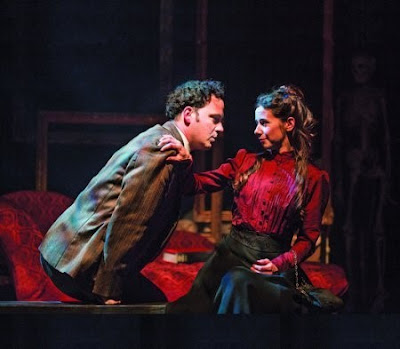Theater: Maugham's Of Human Bondage adapted for the stage
The Soulpepper Theater in Toronto is Canada’s largest
repertory house, presenting a diverse mix of musicals, straight plays, and
single person performances. This summer they took the financial risk of playing
a mini-season in Manhattan, bringing 20 or so players and seven shows. Their
actors have diverse talents, for example offering after-theater cabaret shows
in the lobby. The managing director Albert Schultz seems to foster a
family-like and Canada-centric environment with his troupe, introducing
himself (as director) and each player in Of
Human Bondage personally after the play was done, emphasizing the Canadian
roots of all the actors. Based on the evidence of the performance I saw, the
troupe has excellent acting skills and creative production and directing. I am
less certain of the choice of repertory as a match for Manhattan.
virtues of “the simplest pattern, that in which a man was born, worked, married, had children, and died”, quite different from the outcome of, say, Joyce’s Stephan from Portrait of an Artist as a Young Man, who abandons the familiar or safe course to pursue his life passion (art).
While the plot felt a bit dated to me, the production used many modern (and trendy) stage devices that I have seen recently in other plays. Philip’s entrapment was emphasized by his staying within a square, red-floored stage space throughout the play, including at intermission when he stayed there in fetal position as the audience exited and re-entered. This was similar to the claustrophobic square that Ivo van Hove used in last year’s A View from the Bridge. Several of the characters played musical instruments or percussed/sang special effects when not acting, reminiscent of John Doyle’s Sweeney Todd, memorable for Patti LuPone playing the tuba when not being Mrs. Lovett. To emphasize Philip’s artistic talents, most scenes had female actors placed around the stage periphery holding picture frames to their faces, as living demonstrations of his past, and frustrated artwork. Schultz kept the staging moving briskly, and his actors played multiple parts without confusion. A standout in the ensemble troupe was Michelle Monteith (seen below), who played Philip's dysfunctional codependent lover Mildred, at first a gold digging society woman, later a prostitute dying of syphilis. She was virtuosic in her accent, sudden changes of temperament, and manipulative depiction.
Props and settings were minimal and effective, sparely focusing us on the characters. This was a nice job of translating the detail and complexity of a novel to the stage. Yet for me the technical panache and overall acting quality did not add up to a compelling evening at the theater. I grew impatient with Philip’s dithering (perhaps a younger actor might have done this better) and the plot felt like a creaky, sentimental ending to the Victorian era, rather than one contemporary with early Joyce and O’Neill. In the end, Maugham, who grew up in the late nineteenth century, then lived through much of the twentieth, considers but finally shies away from the rebellion that was to characterize the later century. The production, with its modernistic staging, thus felt out of place with the spirit of this novel. The appreciative audience seemed to enjoy what reminded me of the comfortable evenings of theater in middle or suburban America that I remember from my youth. The Soulpepper company, for me, has the technique but not the innovation or edge to be a good fit for Manhattan of 2017.

Comments
Post a Comment